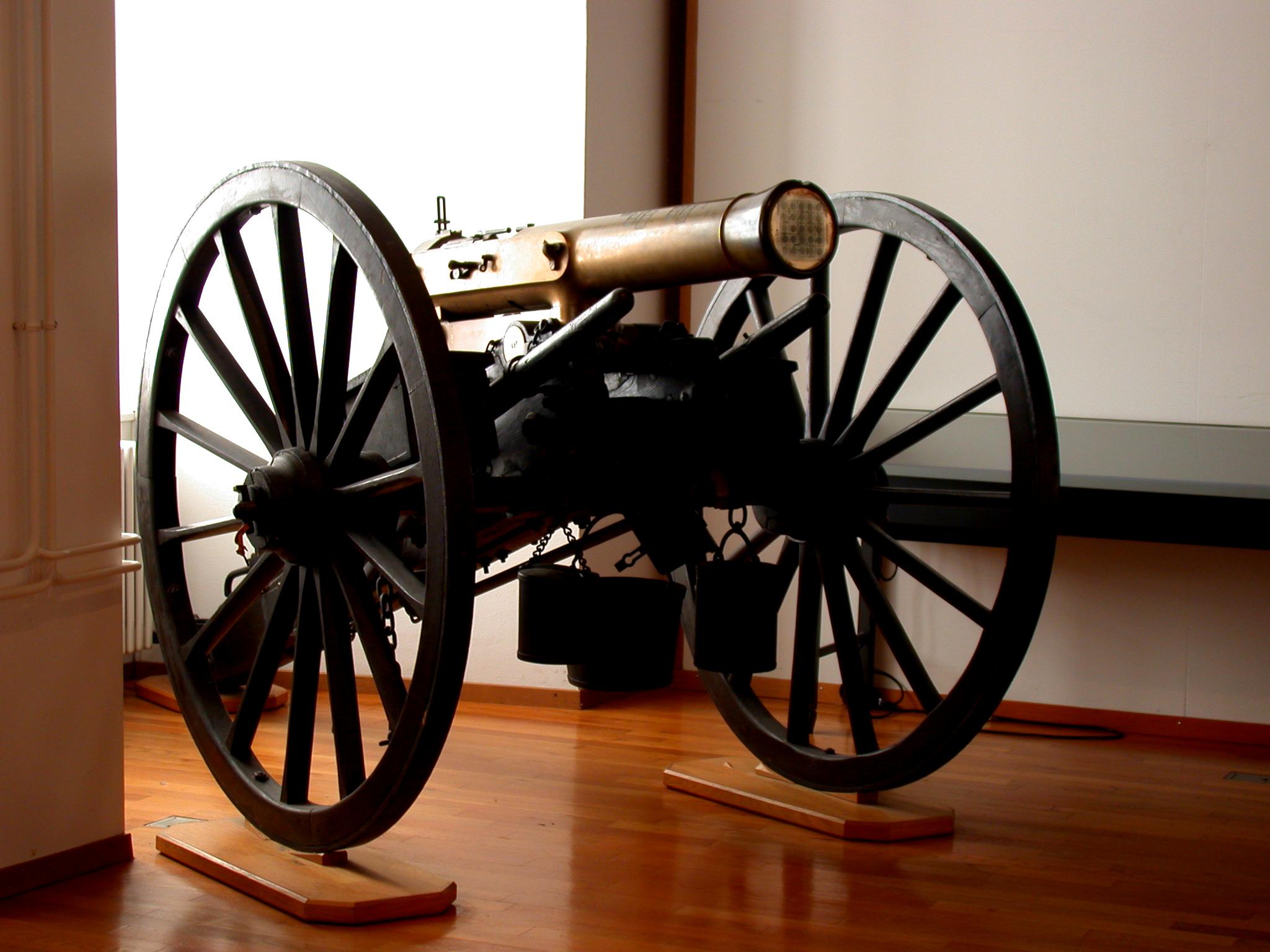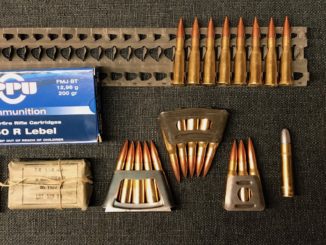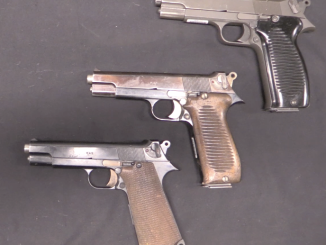Get your “Only Dropped Once” shirt here, and do your part to push back against the stereotype of the French soldier!
The French military had investigated the possibility of a Lebel carbine in the 1880s, but by the 1930s a different set of priorities was in place. In an effort to make some use of the vast stockpiles of obsolete Lebel rifles France had, a plan was put in place to shorten then into carbines for auxiliary troops like artillery crews and engineers. These men needed some sort of rifle or carbine, but they did not need the best and newest weapons. By giving them shortened Lebel carbines, it would free up more modern rifles like the M34 Berthiers in 7.5mm and the new MAS-36 rifles to go to the front line infantry who needed them most.
The R35 conversion was developed by the Tulle arsenal and adopted in January of 1936. The French government ordered 100,000 to be made, and deliveries began in April of 1937. Production would accelerate and continue right up to the spring of 1940, with a total of about 45,000 being actually delivered before the armistice with Germany. The conversions were all assembled at Tulle, but 4 other factories manufactured barrels for them: Chatellerault (MAC), St Etienne (MAS), Société Alsacienne de Constructions Mécaniques (SACM), and Manufacture d’Armes de Paris (MAP). These barrels were 450mm long (17.7 inches), and with the similarly shortened magazine tube, the R35 carbines held just 3 rounds. Production would not continue after the liberation of France in 1944.




A three-round magazine seems to be less than generous considering that artillerymen and truck drivers were not immune to getting attacked face to face by enemy infantry. At least a carbine or short rifle packs more punch than a contemporary revolver of the interwar period from fifty feet away. I could be wrong.
“A three-round magazine seems to be less than generous considering that artillerymen and truck drivers were not immune to getting attacked face to face by enemy infantry.”
I would said, bigger disadvantage was inability to load it with either stripper or clip or by changing magazine, thus making it less effective that Berthier 1892 carbine which has also magazine capacity of 3, but consumed 3-round clip. Additionally having new 7,5 mm and old 8 mm was additional logistic burden.
In French service the pistol alternatives for something like the Lebel R35 carbine for artillery and support troop’s would have been Eibar/Ruby pistols and Mle 1873 revolvers. Mle 1892 revolvers were still issued to officers in 1940. The Rubies were a .32 ACP chambered maintenance nightmare with often no parts interchangeability between manufacturers, and the Mle 1873 was a black powder gate loader revolver with a quite anemic cartridge. No doubt the R35 was a better alternative in most circumstances.
When you have to consider the Lebel rifle capacity, you must count the tubular magazine capacity plus 2 more cartriges : 1 in the chamber, the other in lifting mechanism. (sorry for forgetting the exact English name of what is called “auget élévateur” in French manuals).
Standard Lebel rifle is 8+1+1 = 10 rounds
Shortened R35 is 3+1+1 = 5 rounds
Okay, so it does have a 5-round capacity. Rapid reload is not an option with the R35, a big disadvantage against rifles with box magazines.
“Lebel(…)1 in the chamber”
Wait. Has Lebel mechanism allowing carrying it safely with chambered round?
Daweo:
No, there’s no safety on a Lebel, so realistically it can’t be carried with a round in the chamber. The most the R35 carbine could safely hold is four rounds.
Although it does have a quite heavy trigger, so loading a round in the chamber when combat is imminent is probably not too unsafe. It was never an official doctrine as far as I know, but have made sense for example just before a scheduled attack.
This was probably suitable arm for garrison crews. Imagine the bang it gave in close confines of fortification… (did they issue earmuffs with it?).
Probably not. The guards wouldn’t be trusted to patrol well if they could not hear potential intruders (saboteurs never announced their presence with megaphones). How many people sleep on the job? I hope not many. But that’s moot if the danger happens to be planes, tanks, or artillery.
Denny:
You may have a point. The French placed their hopes of homeland defence in the Maginot Line, which had to be garrisoned by large numbers of soldiers. A very short carbine like the R35 would have been convenient for these soldiers, who basically lived undergound. The carbine would have been very much a back up weapon for these men, who would have been crewing the various artillery pieces and machine guns which armed the Maginot Line.
If you want a rifle which is very short and handy, and will probably never be needed except in extremis, the R35 begins to make sense. But I still argue a 24 inch barrel and five round capacity wouldn’t have been such a bad idea!
I can understand why the French wanted to make use of their huge stocks of Lebels, and why they wanted a handier rifle. What puzzles me is why they went for a carbine with an 18 inch barrel, which meant the gun could only hold three rounds in the tube magazine. If they had remanufactured them as standard short rifles with a 24 inch barrel they could have held five rounds, been much better to shoot, and still have been handy weapons. I don’t think British engineers or artillerymen found the SMLE to be too long for their needs.
The original Lebel was way too long and unwieldy, and then the French went to the other extreme and made it too short. A very odd choice in my opinion.
“original Lebel was way too long and unwieldy, and then the French went to the other extreme and made it too short”
It reminds me one things:
There is a phenomenon of psychology that some people are prone to zealotry. It does not matter what they believe in, when they come to believe in something they believe in it with all their heart. This type of individual who is likely to end up becoming a fanatical member to a certain ideology will if they somehow become disillusioned with it, often find it easier to adopt an opposing or opposite ideology and be just as fanatical to said new cause rather than simply moderating their commitment to their first ideology as needed and making caveats and exceptions to its general principles.
While I agree with you in general, the French had a different set of priorities. The Lebel R35 was never intended to be a rifleman’s weapon. Instead it was basically the French interwar idea of a PDW for artillery and support troops, in other words it was supposed to be carried a lot, but fired very little. The French clearly believed that even a short rifle was too heavy and unwieldy for such a purpose and were willing to sacrifice magazine capacity and “shootability” for a lighter and handier weapon. It also saved some materials by having a shorter barrel.
As for the capacity issue, I don’t believe there is any actual written evidence on how the R35 was loaded and carried. There is no doubt that the French pre-WW1 infantry regulations for the Lebel said that it should be loaded to full magazine capacity (8 rounds) and carried like that.
However, the R35 was not primarily an infantry weapon and the aforementioned regulations were decades old when they were issued. Since there is no evidence, we can’t still just assume that the regulations were changed. However, there is one piece of circumstancial evidence: ammunition for Lebels was issued in packets of eight rounds, which is exactly two times four rounds; enough to load the R35 twice if one round was carried in the lifter (3 + 1). If the gun was loaded only with three rounds in the magazine, one would have had to load no less than eight times (3×8) in order to even out eight round packets. That’s a pretty strange coincidence. Not proof, of course.
“Carried a lot but fired very little” is a big factor in military weapons design and adoption. The M1 Carbine was designed for that reason. The US Air Force adopted the AR15 over Army objections for the same reason.
Too long… not necessarily, considering when it was designed, as it would have been a suitable anti calvary pike with the bayonet affixed. The additional reach would have been welcome.
“In an effort to make some use of the vast stockpiles of obsolete Lebel rifles France had, a plan was put in place to shorten then into carbines for auxiliary troops like artillery crews and engineers.”
Apparently, according to https://forum.axishistory.com//viewtopic.php?t=66044&start=15&sid=00dc608445843bbbac8a5f34f3c23042
French in inter-war period deemed sub-machine gun as useful in two roles:
– raid/infiltration similar to German Stosstruppen usage in Great War, these were for 9×19 Parabellum cartridge
– personal defense weapons in 7,65 mm long cartridge
you can see two examples of French 7,65 mm sub-machine gun of inter-war period.
1st from top: Mle 1939 by Petter (designer of Mle 1935 automatic pistol)
2nd from top: ETVS
both have foldable stocks and magazines
Due to various reasons, sub-machine gun were produced in limited numbers and France used sub-machine guns from various sources when war was raging out
The stacking rod is amusing. I picture tiny little stacks of short little rifles.
Amusing mental image, I agree, but the ability to make “rifle teepees” is very useful especially for artillery. You don’t want to lug a gun on your back while hauling projos, cases and charge bags during a fire mission.
No mention of the short run of r35’s with cut down ww1 era barrels?
Does anybody know if these could take the VB launcher? Or have pictures of it doing so?
It seems that this would be a more logical use for this carbine since the Lebel receiver could handle the effects of the VB launch while the Berthier couldn’t. It would also have been an easier load for the poor Lance-Grenadier of the Combat Section who got stuck with the Lebel and the VB launcher. And yes, I know the VB was supposed to be replaced by the M37 mortar but Ian explained what happened in the vid for that weapon.